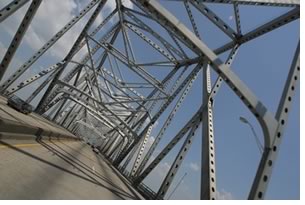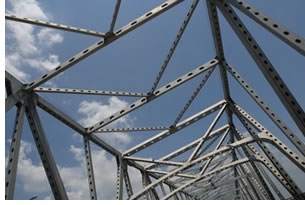

Steel Prices Stabilizing—At
Higher Levels
by
Douglas E. Gordon, Hon. AIA
Executive Editor
The good news, according to steel-manufacturer representatives, is that steel prices have hit their peak and will stabilize by mid-summer. The bad news: Prices will stabilize at about $500 per tonne for hot-rolled steel and will stay that high for at least the next three years. China is the biggest steel consumer now, and India could be next, possibly shifting the balance of trade for the remainder of the century.
 In a
teleconference on “Steel Market Changes,” April 22, sponsored
by the National Association for Business Economics, representatives from
steel giant Ispat Inland Inc. provided insight into the next few years
of steel supply and demand on the world market. The picture is relatively
good in the short term: the sellers’ market has hit its apex as
of April and the price will stabilize by mid-summer at about $500 per
tonne for the market-index hot-rolled steel. Scrap steel, to which the
price of much of the supply of rebar and steel studs is pegged, will fall
to about $200 per tonne by August but will experience its usual periods
of instability, say Chuck Belanger and Bob DiCianni, both representatives
from Ispat Inland.
In a
teleconference on “Steel Market Changes,” April 22, sponsored
by the National Association for Business Economics, representatives from
steel giant Ispat Inland Inc. provided insight into the next few years
of steel supply and demand on the world market. The picture is relatively
good in the short term: the sellers’ market has hit its apex as
of April and the price will stabilize by mid-summer at about $500 per
tonne for the market-index hot-rolled steel. Scrap steel, to which the
price of much of the supply of rebar and steel studs is pegged, will fall
to about $200 per tonne by August but will experience its usual periods
of instability, say Chuck Belanger and Bob DiCianni, both representatives
from Ispat Inland.
Depending on the U.S. dollar staying weak on the world market and our economy holding strong, the huge demand from China for steel will not necessarily create another precipitous increase in the price of steel in this country, the steel insiders predicted.
The cause of the recent boom in steel prices is the “perfect storm” based on 20 years of developing circumstances, Belanger and DiCianni agreed. With world steel prices plummeting due to an oversupply, steel producers from the U.S. to Australia had for a generation slowed production. The mining of iron ore and other steel-producing elements, such as manganese, also slowed or stopped over the last 20 years. In the 1970s and 80s, mini-mills economically supplied the demand for steel by converting scrap steel from old cars to demolished bridges into rebar, steel studs, floor and roof decks, and more. Scrap steel has always been a fluctuating commodity, and became even more instable when China began its enormous boom a few years ago. As demand has increased, supply remains fairly steady, with only developed countries—notably the U.S. and in Europe—having a significant supply of steel being scrapped.
 Added to the mix is
the decades-long fall in shipping tonnage. With a long spate in the construction
of transport ships—except, perhaps, for oil freighters—the
capacity for bulk shipping is about three years behind the current demand,
according to the Ispat Inland experts. The result is an exacerbating cost
increase in the global shipping of coal, coke, iron ore, and, ultimately,
steel, they say.
Added to the mix is
the decades-long fall in shipping tonnage. With a long spate in the construction
of transport ships—except, perhaps, for oil freighters—the
capacity for bulk shipping is about three years behind the current demand,
according to the Ispat Inland experts. The result is an exacerbating cost
increase in the global shipping of coal, coke, iron ore, and, ultimately,
steel, they say.
Furthermore, with world production of steel down, China has decided to take a tremendous leap. Chinese leaders are looking to the 2008 Olympics as a chance to reestablish their nation as a world power. One of their first apparent surges was the Three Gorges Dam, the largest hydroelectric dam in history, consuming untold resources in terms of capital, people, and steel. (It should be noted, the presenters said, that China is most often oblique if not outright opaque in its dealings, and, therefore, actual figures on steel consumption are extremely difficult to determine or predict.) To put China’s ambitious construction plans in perspective, they will be building the equivalent of 10 cities the size of Columbus, Ohio, over the next five years.
Even if the current speculative bubble for steel fizzles (there are reports that Chinese buyers are currently offering prices of $100 per tonne above world market rates for steel), the Chinese economy will prevail as “the 500-pound gorilla,” Belanger and DiCianni concurred. So steel prices will stay high. Moreover, all materials are likely to rise dramatically in cost in the U.S. if our base-materials production stagnates and world demand increases. It will take suppliers years to catch up as investment capital wends its way back into the vast infrastructure of mining and steel making.
 And even if China
does slow down, India, with 1.2 billion people, is the next sleeping giant
on the horizon. The subcontinent is poised to take its place as a super-consumer
on the world market over the coming decades. Also ripe for burgeoning
growth is Eastern Europe, Belanger and DiCianni advised.
And even if China
does slow down, India, with 1.2 billion people, is the next sleeping giant
on the horizon. The subcontinent is poised to take its place as a super-consumer
on the world market over the coming decades. Also ripe for burgeoning
growth is Eastern Europe, Belanger and DiCianni advised.
For the time being, the steel-products producers are trying to hold the line on prices, they contended. But consumers will have to prepare for higher prices in the long term. As Belanger summed up the cause and effect of the recent surge in materials prices: “You can ignore the laws of economics for awhile, but you can’t avoid them altogether.”
Copyright 2004 The American Institute of Architects.
All rights reserved. Home Page ![]()
![]()
 |
||
| For more
information about the National Association for Business Economics,
visit their Web site.
|
||